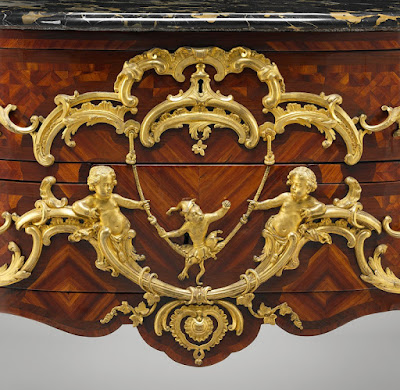Who was William Hallet, Esq.? The Great Dictionary is silent concerning him, notwithstanding his purchase of a fine the estate of the Duke of Chandos. The "person in the Jersies" served him as foreman from 1738 to 1749. Were the chairs, with back "done after the pattern of some of the Queen's," of Chippendale design? If so, it ought to have been worth while to mention that fact if Chippendale was a recognize authority, and to have claimed that latter as a master rather "then great and eminent cabinet-maker, William Hallet, Esq." Even if the advertisement was as catch-penny scheme, it is plain that in 1771 the name of Hallet was considered a better bait in New York than that of Chippendale: and this was only nine years after the latter had issued the third edition of his book. It is also worthy of note that no tradesman whose advertisement I have seen in an American paper prior to the Revolution ever mentions the name of Chippendale in recommending home-made or imported furniture.
We have now arrived at the following facts: before Chippendale brought out his book in 1754, he was no more prominent than many another prosperous cabinet-maker; thirty-five years later, whatever was original and peculiar to him in that work had become "wholly antiquated and laid aside," and, lastly, he never attained such a commanding position in his profession or trade ad did George Kent in his, for instance.
We have seen that hitherto most of the new designs is furniture originated with artists or architects. Chippendale was only a not-very-eminent carver and cabinet-maker. The list of subscribers to his book includes, besides nobility, gentry joiners and carpenters, eighty-three London cabinet-makers, ten carvers and two engravers. M. Darly is one of the engravers; and W. Ince is one of the cabinet-makers. Ince was soon to publish an important books of designs to advertise the product of hi own firm; and Darly was Chippendale's assistant, who engrave and designed some of his plates. In 1773, he published A Complete Body of Architecture, "embellished with a great variety of ornaments, comped, drawn and engraved by Matthias Darly, Professor of Oranament." In the preface he says: Ornamental drawing (drawing of ornament) has been too long neglected in this trading country and great losses have been sustained in many of our manufactures for want of it. On the knowledge of true embellishment depends the improvement of every article and I do aver that this kingdom is more indebted to a Rich'd Langcake (who is now teaching the art of design in France) than to a Sir Godfrey Kneller."
Chippendale has evidently taken to heart Langley's savage attack on the English cabinet-makers.for the ignorance of the sacred Five Orders. It has been a puzzle to many critics to account for the fact that he devotes much space to elucidating that style of architecture and then proceeds to give designs of furniture in the prevailing bastard Gothic and Chinese taste, and ornament the rest with French Renaissance and rocaille details. When we remember Langley's wholes condemnation, however Chippendale's lip-service is perfectly explicable. In his preface, the latter says:
"Of all the arts which are either improved or ornamented by Architecture, that of Cabinet-making is not only the most useful and ornamental, but capable of receiving as great Assistance from it was any whatever. I have therefore prefixed to the following designs a short Explanation of the Five Orders. Without an acquaintance with the Science and some Knowledge of the Rules of Perspective, the Cabinet-maker cannot make the Designs of his work intelligible, nor shew in a little Compass, the whole Conduct and Effect of the Piece. These, therefore, ought to be carefully studied by everyone who would excel in this Branch, since they are the very Soul and Basis of his Art.



1 comment:
Informative post, thanks for sharing
Post a Comment